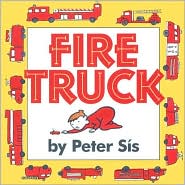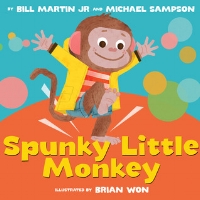Introduction: Our next book is Cat on the Bus by Aram Kim. This book is almost wordless, hardly any words, so you can help me tell the story from the pictures. We are going to look carefully at the faces of the characters, the cat, the man, and the girl. I would like you to tell me how you think they are feeling.
[Read the book together, talking about the feelings of the characters. Use words for feelings that may not be so familiar. In addition to happy and sad, you might add curious, confused, disappointed, overwhelmed, content, friendly, joyful, and more.]
Example Aside: Vocabulary: When we add less familiar words to ones that children already know, we are building their vocabulary which will later help them understand what they read. OR
[Read the book together, talking about when children have felt the way the characters in the book have. You may have this discussion after the end of the book; you need not interrupt the story.]
Example Aside: Background Knowledge: When we relate something in the story to the child's own experiences, we help them make the connection between the story and themselves which helps them understand the story.
Spunky Little Monkey by Bill Martin Jr. and Michael Sampson
Introduction: Our next book is called Spunky Little Monkey by Bill Martin Jr. and Michael Sampson. It is illustrated by Brian Won. [Remember Hooray for Hat? Brian Won wrote and illustrated that book, too! Bill Martin, Jr. wrote Brown, Bear, Brown, Bear, What Do You See?]
I'd like you to help me with reading this book. The monkey is getting some exercise and does somemovements to sounds. So, when it says the rhythm of the head, the sound is ding-dong and we move our head from side to side. Let me see you do that. Great! When it says rhythm of the hands, then we clap twice, clap clap. Try that. Great! For the feet, it says stomp stomp, so stomp your feet twice. Good! And then for the rhythm of the hips, it says shake, shake so wiggle your hips. OK! Let's try it.
[Read the book, having them join in. Repeat the movements in sequence till the children are comfortable with it--the page with ding dong, clap clap, stomp stomp, shake shake] Yay! You got the pattern--ding dong, clap clap, stomp stomp, shake shake!
Early Learning Aside--Example--Math Concepts--Patterns: Adults, in math, a repeated sequence is a pattern. When we did the repeated motions over and again, they could notice the pattern and begin to anticipate what comes next. This fun activity and book helps to build math skills!
Early Learning Aside--Empower: You can notice patterns or make up movement and clapping patterns throughout the day. Lots of fun and builds math skills, too.
Little You by Richard Van Camp

Using a baby doll or stuffed animal as a baby, demonstrate reading this book using more words than what is in the text. For example page 1: Little you, little wonder. Point to the parents and to the child. Here is the father and the mother and there is the little baby. There is a big round red sun in this picture (as you point to it) and a little flower with a ladybug. They look happy together, they are smiling. Another example, page 3: Little wish, gentle thunder. Let's see what is in this picture; there's a cat and a little kitten, a baby cat, just as this mother is holding her baby. And look out the window, there is a crescent moon. It looks dark outside. We see a flash of lightning that also comes with thunder. When I was little I used to be afraid of storms, especially when the thunder was so loud.
Early Literacy Aside--Explain: In today's storytime I'll be pointing out different ways you can read with your baby. Reading with your children is the single best thing you can do to help them become good readers later. There are many ways to read and share books with young children and I'll be pointing out some today.
Early Literacy Aside--Example: When you read to your baby and the book has only a few words on the page, take time to add your own words about the picture or about things the picture makes you think about. This adds to your baby's vocabulary and background knowledge which will make it easier for them to later understand what they read.
You can have a few minutes of Read Together time where you pass out board books for each family and have them add words to the few in the book. They may not get through the whole book. That's fine! They are enriching their babies' language experience.
Song: If You Want to Know an Answer
If You Want to Know an Answer is a good opening song especially when you want to emphasize what we can learn from factual books. You can substitute words to emphasize any aspect of learning. Song: If You Want to Know an Answer (tune: If You're Happy & You Know It) If you want to know an answer, read a book! If you want to know an answer, read a book! If you're wondering where the moon goes; If you're wondering how the grass grows; If you want to know an answer, read a book!
If you'd like to learn to draw, read a book! If you want to learn to draw, read a book! If you'd like to draw a dog, Or a frog sitting on a log; If you'd like to learn to draw, read a book!
If you'd like to learn to bake, read a book! If you'd like to learn to bake, read a book! If you'd like to make some candy, Or a pizza that is dandy; If you'd like to learn to bake, read a book!
Early Literacy Aside--Explain--Background Knowledge: Factual books offer many opportunities to add to children's knowledge based on their interests. Sharing factual books not only helps children learn about the world around them, but also will help them later understand what they read. In today's storytime, I'll be pointing out different ways to share factual books and information with children.
Animals Storytime Handout
Animals Storytime Handout animalhandvocabcarolwagstaffdouglascolplby Carol Wagstaff, Douglas County (CO) Public Library
My Face Book by Star Bright Books--bilingual books
Video clip on using bilingual books, example of My Face Book from Star Bright Books
Video clip here
Effective Early Literacy Aside--Video Clip
Video clip explanation and demonstration of ineffective and effective early literacy asides.
Click here
Saroj Ghoting, Early Childhood Literacy Consultant
Fire Truck by Peter Sis

Introduction: This book Fire Truck, written and illustrated by Peter Sis, has lots of interesting words in it.
Early Literacy Aside--Example: Listen to the many different words your child is hearing, words we might be using in everyday conversation. Because books have three times as many rare words as we use in conversation, it is important for children to hear the language of books. As I'm reading this book, just hold up a finger when you hear a word you would not be using everyday when talking with your child. Then we'll see how many you heard at the end of the book.
Read the book. Ask how many words they heard that they would not use in conversation with their children.
Early Literacy Aside--Empower: As you read books at home with your children, you may notice some words they are not familiar with. You don't have to explain every unfamiliar word, but you might choose one to point out and explain. Don't replace unfamiliar words, or they won't hear them. This is how you help their vocabularies grow!
Talking while reading
 Early Literacy Aside--Explain: Talking with your children while reading, encouraging them to make comments and ask questions is one way to share a book that develops your child's understanding of the book. Make reading with your child a postive experience by allowing your child to make comments and ask questions. Try to focus all your attention on your child for that time.During the storytime, demonstrate these techniques with one or more of your books. Point out what you are doing.
Early Literacy Aside--Empower: Talking with your children and giving them time to respond is supervaluable, even in a conversation consisting entirely of baby babble. This helps your children develop conversation skills. Remember that it can take young children from 5 to 12 seconds to process a question and formulate a response, so it's really important to gie them that extra time to express themselves.
Early Literacy Aside--Explain: Talking with your children while reading, encouraging them to make comments and ask questions is one way to share a book that develops your child's understanding of the book. Make reading with your child a postive experience by allowing your child to make comments and ask questions. Try to focus all your attention on your child for that time.During the storytime, demonstrate these techniques with one or more of your books. Point out what you are doing.
Early Literacy Aside--Empower: Talking with your children and giving them time to respond is supervaluable, even in a conversation consisting entirely of baby babble. This helps your children develop conversation skills. Remember that it can take young children from 5 to 12 seconds to process a question and formulate a response, so it's really important to gie them that extra time to express themselves.
Submitted by Cindy Christin, Bozeman (MT) Public Library and Tracey J., Sacramento (CA) Public Library


